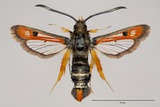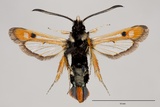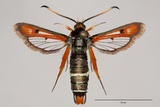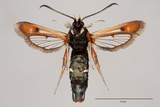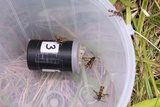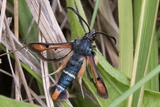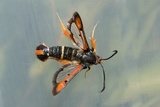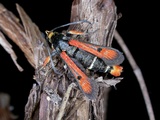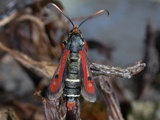Pyropteron chrysidiformis (Esper, 1782) Species
Last modified: May 14, 2024, 10:21 a.m.
This is a very rare species in Belgium only known from three provinces in the southern part of the country. After a long time of absence found again in 2019 in LX where a stable population is present.
Details
- Classification
- Family: Sesiidae > Subfamily: Sesiinae > Tribus: Synanthedonini > Genus: Pyropteron > Species: Pyropteron chrysidiformis
- Vernacular names
- Zuringwespvlinder (NL), Fiery Clearwing (EN), Sésie de l'Oseille (FR), Roter Ampfer-Glasflügler (DE)
- First mention in Belgium
- De Sélys-Longchamps E. 1837. Catalogue des Lépidoptères ou Papillons de la Belgique, précédé du tableau des Libellulines de ce pays. — — : 1–29. On page 21 (as Sesia Chrysidiformis). view page
- Status
-
Native
Distribution
Imago
P. chrysidiformis is a medium-sized species (15–25 mm) that is the easiest recognisable Belgian species by the predominantly orange-red forewings. The transparent areas on the wings are small and the discoidal spot on the forewing is black. The black abdomen has 3 small white bands in the ♂ and 2 in the ♀. The rather hairy hind-legs are orange-red too as is the middle of the anal tuft. The latter is black at the sides. The proboscis is, as in all species of this genus, well developed and functional.
The males are fairly well attracted to a variety of different pheromone compositions but the one originally developed for S. myopaeformis appears to be more efficient than the other compositions . This species is best lured before noon but the optimal time span is very weather dependent.
Egg
The eggs are black and elliptically shaped.
Caterpillar
The larva is off-white and has a dark-brown head with some lighter stains. As in all Sesiidae, the prolegs have a double wreath of small hooks.
Mine
The caterpillar makes irregular galleries in the root of the hostplant.
Bionomics
The eggs are deposited on a stalk of the hostplant or on the upper- or underside of a leaf. The young larva initially lives just under the rind in a flat mine in the transition zone between stem and root. Later on, the caterpillars bore deeper into the root and make fairly long galleries. Initially, since the inside of the roots is yellowish, the frass is yellow but after a while it colours black. This way, infested roots are easily recognised because of the black colouration of these roots. For there are often several caterpillars in one root they can cause such substantial damage to the root system that it is not uncommon they kill the hostplant. After the hibernation, that takes place inside a root gallery, the caterpillars construct an exit gallery to the upper part of the root of in the lower part of a stem. Only occasionally a loose cocoon is constructed. Hence, the development completes in one year. Parasitism by flies (mostly Tachinidae) can be considerable. On hatching, the pupa works its way out through the cocoon and remaining thin bark layer.
Flight periods
The adults fly from early June till mid-July.
Observed on
- Host plant (species):
- Rumex obtusifolius and Rumex sanguineus
- Host plant (genera):
- Rumex
The larva bores into the roots of several Rumex species (e.g. Rumex obtusifolius and Rumex sanguineus).
Habitat
This species prefers xerothermic and not too wet biotopes such as road sides, waste places, embankments, ...
